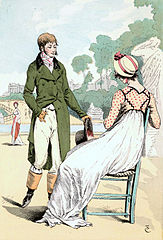
Though clothing for an 18th century gentleman was less cumbersome than it was for women, getting dressed was more complicated than slipping on slacks and a dress shirt.
Like their female counterparts, 18th century men didn’t bother much with basic undergarments. Though underbreeches existed, most men took advantage of their long shirt tails to provide cushioned coverage.
The 3-piece suit of breeches, waistcoat, and coat became standard male attire in the 17th century, though styles, colors, and fabrics varied
In general, a gentleman owned several pairs of breeches [also known as pantaloons], various coats, a few vests, and six shirts, in addition to stockings and buckled shoes.
The Multi-Faceted Shirt
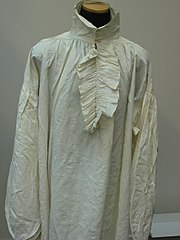
Only the wealthiest men had enough shirts to set one or more aside as ‘night shirts.’ Men wore the same shirt to bed they had worn all day, and, if it wasn’t soiled, continued to wear it the next day.
Shirts with elaborate cuffs or ruffles indicated wealth, since the individual wearing such a shirt obviously wasn’t concerned about soiling the cuffs.
The voluminous shirt was pulled over the head, and had a small vertical slit at the neck. The full shirt also had billowy sleeves with square shaped gussets under the arms for ease of movement.
Shirt cuffs fastened with a pair of cuff buttons linked by a chain. These were the forerunners of modern cuff links which in turn have been replaced with cuffs that button.
After donning the shirt, a man pulled his silk or wool stockings up and over the knee. Later they would be held in place by a band on the breeches.
Breeches
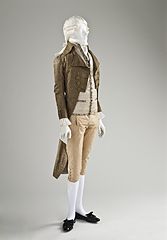
Breeches featured fairly straight legs and a fall flap that lifted up from the groin area to the waistline where it buttoned onto the waistband. The width of the flap determined whether the breeches were ‘broad falls’, or ‘narrow falls.’
Breeches were cut full at the back and gathered at the waist with a vent so the wearer could easily sit or ride. There was usually at least one pair of pockets.
Breeches were closed at the side of the knee with buttons, and the knee bands, which held up the stockings, usually closed with buckles or buttons below the knee.
Hair & Make-up
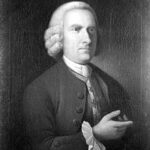
At this point, it’s time to put on the wig. Men put on a wrapper to protect clothing and a mask to cover the face while an assistant attached the wig and dusted it with powder made from starch scented with lavender or orange. The powder came in several colors, including grey, black, brown, white, or blue. Color selection related to class and profession. Judges and gentlemen, for example, used white.
Men were clean-shaven which provided a sort of balance with the fashionable wig most, but not all, men wore. George Washington, for example, wore his own hair which he powdered white. But back to wigs. The fashion started in the 17t century to cover hair loss. Wigs were made of human hair, which was very expensive, or yak, horse or goat hair. As animal hair aged, it could develop an odor which is why hair powders were scented.
Gentlemen might also apply white powder to accentuate pale skin, and perhaps a touch of rouge on the lips.
Waistcoats
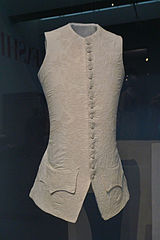
The waistcoat either matched or contrasted with the outer coat, and buttoned down the front. The top buttons were left undone so the shirt ruffles could be pulled through.
At this point, the shirt collar was closed with either buttons or tape. A fine linen cravat or stock made of pleated linen covered the shirt collar. For more formal occasions, the cravat or stock would be made of silk
Coats
Fully lined coats came in several styles and were made of wool, linen, or silk They might stop at the waist in the front, and have thigh-length tails at the back.
A frock coat came to the thigh with a narrow or moderately full skirt with a center back vent so the coat could be pulled up or to the side for sitting or riding. The sleeves didn’t have a substantial cuff. By 1780 the wool frock coat was acceptable for all but formal occasions. Coats were usually left unbuttoned
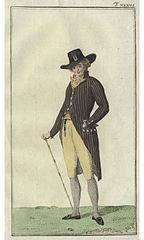
One, Two, Buckle the Gentleman’s Shoe
Shoes usually had round toes with a slight heel and buckled over the top of the foot. Plain steel buckles served for daily wear and silver buckles with precious stones or glass imitation stones for special occasions.
With the final addition of a hat and walking stick, the 18th century gentleman was ready to go about his business.
If you’d like to watch how everything fits together, you might enjoy the short video below. I’d be interested to know what occasion this “gentleman” was going to attend — you wouldn’t wear coat like that for a stroll around the neighborhood.
🎩. 🎩. 🎩
On the Terrace at Tuileries, 1798.
Man’s Shirt, 18th century. Attribution: Auckland Museum.
Man’s 3-Piece Suit, 1786.
Man’s Waistcoat, 1760. Photo by Marshall Astor.
Portrait of a Man, 1765.
Englishman, 1786.
Douglas Perkins. “Why did Colonial Men Wear Wigs?” Medium.
Lydia Edwards. How to Read a Suit: A Guide to Changing Men’s Fashions from the 17th to the 20th Century. Bloomsbury Visual Arts. 2020.

Sandra Wagner-Wright holds the doctoral degree in history and taught women’s and global history at the University of Hawai`i. Sandra travels for her research, most recently to Salem, Massachusetts, the setting of her new Salem Stories series. She also enjoys traveling for new experiences. Recent trips include Antarctica and a river cruise on the Rhine from Amsterdam to Basel.
Sandra particularly likes writing about strong women who make a difference. She lives in Hilo, Hawai`i with her family and writes a blog relating to history, travel, and the idiosyncrasies of life.

